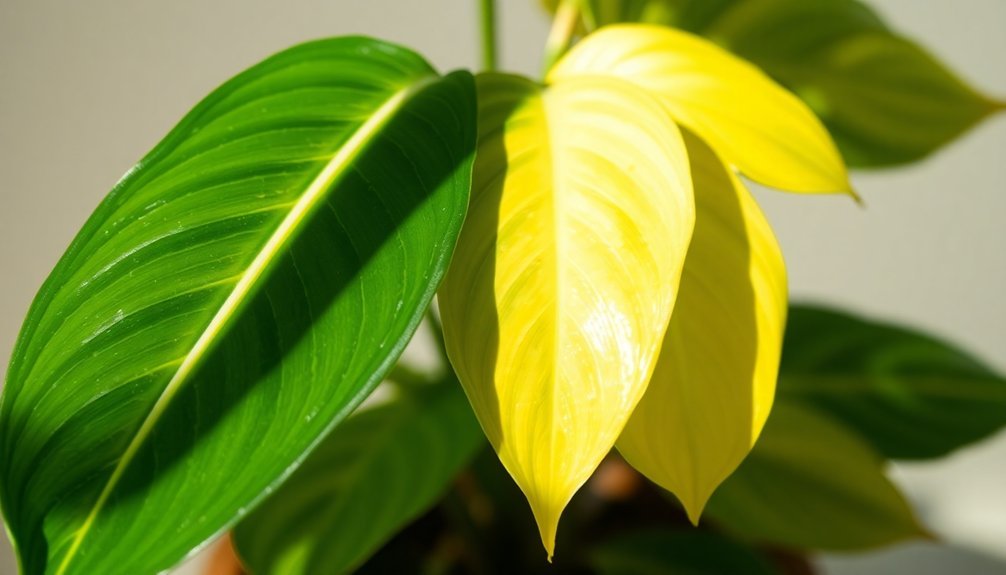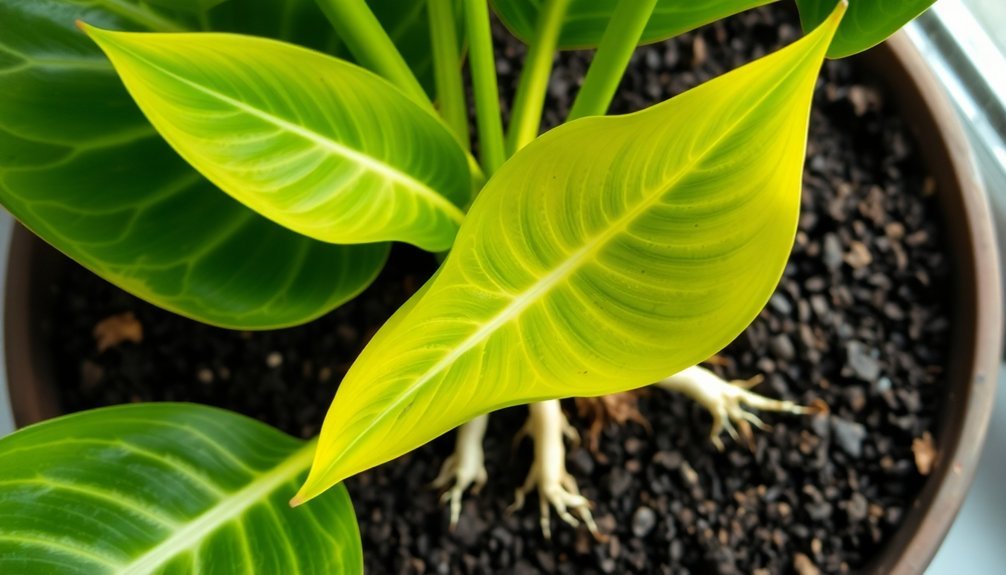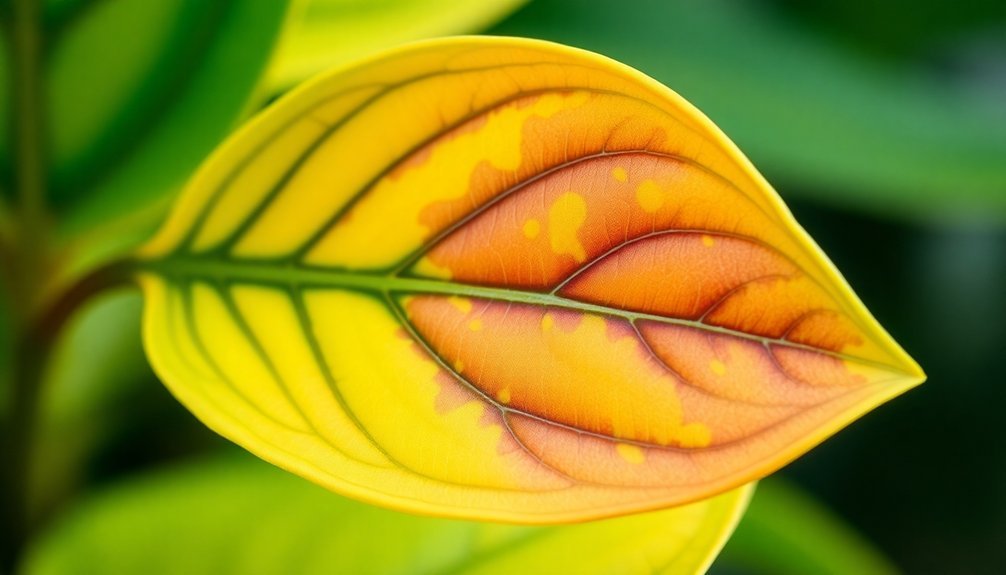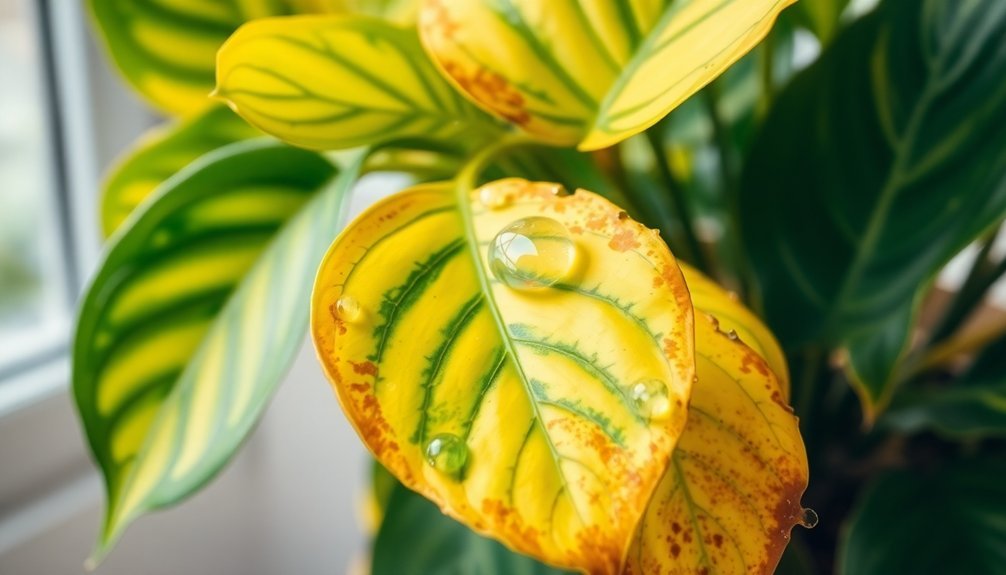Yellow leaves on houseplants typically indicate nitrogen deficiency, overwatering, or insufficient light. You'll spot nitrogen issues when older leaves yellow from bottom up, while overwatering causes soggy soil and blackened stems. Check for proper drainage holes, maintain soil pH between 6.0-7.0, and guarantee plants receive adequate light. Combat issues with balanced fertilizer, consistent watering schedules, and regular pot rotation. Understanding your plant's specific needs will help prevent future yellowing problems.
Identifying Common Signs of Nitrogen Deficiency

When your houseplant's older leaves begin turning yellow from the bottom up, you're likely dealing with nitrogen deficiency. This common nutrient issue affects your plant's ability to produce chlorophyll, leading to pale, yellowing leaves and stunted growth patterns.
You'll notice the yellowing of older leaves starts at the base and gradually moves upward as the deficiency becomes more severe. Your plant may also struggle to develop flowers and fruits properly, since nitrogen is essential for healthy vegetative growth.
To confirm if nitrogen deficiency is the culprit, consider getting a soil test – the ideal nitrogen level should be around 15-20% of total nutrients. If you spot these symptoms, you can remedy the situation by applying a balanced fertilizer containing nitrogen, such as Pennington Rejuvenate Plant Food.
Watering Problems and Yellow Foliage
Although watering seems straightforward, it's one of the most common causes of yellow leaves on houseplants. Both overwatering and underwatering can trigger yellowing leaves, making it essential to find the right balance for your plants.
To prevent moisture-related problems, check your plants regularly and look for these key indicators:
- Overwatering signs: soggy soil, blackened stem bases, and heavy pots
- Underwatering signs: dry, crumbly soil, and wilting foliage
- Proper drainage: verify pots have drainage holes and use well-draining soil
You can maintain healthy foliage by establishing a consistent watering schedule based on your plant's specific needs.
Test soil moisture by inserting your finger about an inch deep or by lifting the pot to feel its weight. This simple practice helps you develop an intuitive understanding of when your plants need water.
Light Exposure Impact on Leaf Color

You'll often notice your houseplant's lower leaves turning yellow when they're not getting enough light, particularly on the side facing away from windows or light sources.
Understanding the difference between direct and indirect light requirements for your specific plant can help you choose the ideal spot, whether it's near a sunny window or in a partially shaded area.
As seasons change, you'll need to adjust your plant's location to compensate for variations in natural light intensity and duration, ensuring consistent, healthy growth throughout the year.
Identifying Light-Related Yellowing
Identifying light-related yellowing in houseplants starts with understanding its telltale patterns. When your plant isn't getting enough light, you'll notice leaves turn yellow first on the lower portions, as the plant redirects energy to new growth.
Insufficient light often causes uneven yellowing, particularly on sides facing away from light sources.
- Lower leaves yellowing and dropping indicate your plant needs more overall light
- One-sided yellowing suggests uneven light distribution
- Gradual color loss across multiple leaves points to general light deficiency
You can address these issues by rotating your pots regularly to guarantee even exposure and gradually moving plants to brighter spots.
If natural light is limited in your space, consider adding grow lights to maintain healthy leaf color and prevent future yellowing.
Direct Vs Indirect Light
Understanding the difference between direct and indirect light is essential for preventing yellow leaves in houseplants. You'll want to observe how sunlight enters your space and position your plants accordingly. Direct light can cause leaf burn and yellowing, while indirect light promotes healthy growth without damage.
| Light Type | Effect | Solution |
|---|---|---|
| Direct Light | Bleached, yellow leaves | Move plant away from windows |
| Indirect Light | Balanced growth | Place behind sheer curtains |
| Low Light | Stretching, yellowing | Add grow lights |
To maintain vibrant foliage, rotate your pots weekly for even light distribution. If you're noticing yellow leaves on one side, it's likely getting too much direct light. Consider using grow lights during darker seasons to supplement natural light, especially for plants that need more brightness to thrive.
Seasonal Light Changes
Seasonal light changes pose unique challenges for houseplant health throughout the year.
When your plants receive insufficient light during fall and winter months, you'll often notice yellowing leaves, particularly on the lower portions and sides facing away from light sources.
To prevent and address light-related yellowing, consider these essential adjustments:
- Rotate your plants weekly to guarantee even light distribution across all sides
- Move plants closer to windows or to sunnier spots during shorter winter days
- Install grow lights to supplement natural light when needed
Root Health and Yellowing Symptoms

When you notice yellow leaves starting from the bottom of your plant, it's time to check for root rot by gently removing the plant from its pot to inspect the roots.
Healthy roots should be firm and whitish-yellow, while dark, mushy roots indicate rot that's likely causing your plant's yellowing symptoms.
You'll need to trim away any rotted sections and repot your plant in fresh, well-draining soil to prevent further decline and help restore your plant's health.
Root Rot Warning Signs
Root rot is one of the most serious threats to your houseplant's health, often announcing itself through yellowing leaves and mushy stems.
When your plant's roots suffer damage from waterlogged potting soil, you'll notice leaves turning yellow even though the soil feels wet. This happens because damaged roots can't deliver nutrients to your plant properly.
Look out for these critical warning signs:
- Dark or black roots instead of healthy whitish-yellow ones
- Wilting despite consistently moist soil
- Stems becoming soft and mushy near the base
If you spot these symptoms, act quickly.
Remove your plant from its pot, trim away any blackened roots, and let the remaining healthy roots dry out.
Replant in fresh, well-draining soil and verify your pot has proper drainage holes to prevent future problems.
Examining Root System Health
Understanding your plant's root system provides clear signals about its overall health, much like reading essential signs. When you inspect the roots, they should appear whitish-yellow and firm. If you notice dark, mushy areas, your plant's suffering from root damage that needs immediate attention.
Watch for yellow leaves, especially on lower portions of your plant, as they're often the first indicator of root health issues. If you spot small, pale leaves or brown splotches on the foliage, it's time to check below the soil.
Verify your soil pH stays between 6.0 and 7.0 for peak nutrient absorption. Don't forget to examine for root-bound conditions – if roots are circling the pot's interior, they're likely compacted, restricting water and nutrient flow.
This compression stress often leads to yellowing foliage and stunted growth.
Soil Quality and Nutrient Balance
Since healthy soil forms the foundation of thriving houseplants, maintaining proper soil quality and nutrient balance is crucial to prevent yellowing leaves.
Using a well-aerated potting mix, like Pennington Rejuvenate Premium All Purpose Potting Soil Mix, guarantees proper drainage and nutrient availability for your plants.
Watch for these key indicators of nutrient deficiency and soil quality issues:
- Yellow leaves starting from older foliage indicate nitrogen deficiency
- Bright yellow leaf edges on mature leaves suggest potassium deficiency
- Compacted soil restricts root growth and nutrient uptake
Keep your soil pH between 6.0 and 7.0 for ideal nutrient absorption.
You'll want to conduct regular soil tests to monitor pH levels and aerate the soil periodically.
Remember to fertilize with a balanced nutrient solution to replenish essential elements your plants need.
Temperature Stress Effects on Plants

Temperature fluctuations can wreak havoc on your houseplants, causing yellowing leaves and compromised growth patterns. When your plants face temperature stress outside their comfort zone of 60-85°F, you'll notice signs of distress, particularly leaves turning yellow or becoming pale and whitish.
Sudden temperature changes stress houseplants beyond their 60-85°F comfort zone, leading to yellow leaves and stunted growth.
Keep an eye out for cold drafts from air vents or windows, as they're often the culprits behind sudden leaf drop and discoloration.
If you're planning to move your plants outdoors for spring, do it gradually to prevent shock from abrupt temperature changes. Remember, your plants need time to adjust to new conditions.
To protect your houseplants from temperature-related yellowing, maintain a stable environment and consistent care routine. Proper watering and humidity levels will help strengthen their resilience against temperature fluctuations.
Pest Infestations and Leaf Discoloration
When your houseplants develop yellow leaves, pesky insects might be the hidden culprits draining their energy. Pest infestations like spider mites and aphids feed on your plant's sap, causing nutrient deficiencies that result in yellowing foliage.
You'll often notice the discoloration starting on lower leaves or areas away from light sources.
Look for these tell-tale signs of common pests:
- Spider mites leaving fine webbing between leaves
- Aphids clustering on new growth and leaf undersides
- Yellowing patterns that spread from the bottom up
You can combat these unwanted visitors by applying insecticidal soap or neem oil directly to affected areas.
Don't forget to increase humidity around your plants – it's an effective preventive measure since many pests prefer dry conditions.
Regular inspection and prompt treatment will keep your plants healthy and vibrant.
Disease Recognition and Treatment

You'll need to watch for telltale signs of disease in your houseplants, including fungal infections that create spotted yellow leaves and viral infections that cause leaf deformities with blotchy patches.
Early detection is vital, so inspect your plants weekly and isolate any showing symptoms to protect your other plants from infection.
To treat and prevent diseases effectively, maintain proper air circulation, reduce excess moisture, and always use sterilized tools when handling affected plants.
Identifying Common Plant Diseases
Discovering signs of disease in your houseplants early can mean the difference between saving them and losing them entirely. When you notice yellow leaves, it's essential to identify common reasons quickly, as plant diseases can spread rapidly throughout your collection.
Pay close attention to unusual patterns and discoloration that might indicate underlying problems.
Look for these key warning signs:
- Blotchy yellow patches and leaf deformities that suggest viral infections
- Visible pests or unusual growth patterns on stems and leaves
- Discolored areas that spread or change over time
If you spot these symptoms, immediately quarantine affected plants and sterilize any tools you've used on them.
Don't wait to take action – early detection allows for more effective treatment options, whether you need fungicides, insecticidal soaps, or adjustments to your plant's growing conditions.
Prevention Through Early Detection
Early detection serves as your best line of defense against plant diseases and yellowing leaves. By establishing a regular inspection routine, you'll quickly notice changes in your plants' health before problems escalate.
Check the undersides of leaves daily for pests like aphids and spider mites that can drain your plant's energy.
Don't forget to monitor environmental conditions around your plants, as sudden changes in light, temperature, or humidity can trigger stress-related yellowing.
Test your soil regularly to identify nutrient deficiencies and pH imbalances before they cause serious damage.
When adding new plants to your collection, always quarantine them first to protect your existing ones.
Remove any yellow leaves immediately to prevent disease spread, and you'll maintain a healthier indoor garden through proactive care.
Effective Treatment Methods
Once you've identified yellowing leaves on your houseplants, proper disease recognition becomes essential for effective treatment. Look for specific symptoms like blotchy patches that might indicate viral infections, or irregular spots suggesting fungal issues.
To maintain ideal plant health, you'll need to take decisive action based on your findings.
- For pest-related yellowing, apply insecticidal soap or neem oil while guaranteeing good air circulation around affected plants.
- When treating fungal infections, immediately quarantine infected plants and sterilize all gardening tools to prevent spread.
- If nutrient deficiencies are causing yellow leaves, apply a balanced fertilizer like Pennington Rejuvenate to restore essential nutrients.
Remember to monitor your treated plants closely and maintain proper growing conditions to prevent future issues.
This targeted approach guarantees you're addressing the specific cause rather than applying general solutions.
Air Circulation and Plant Health
While many plant owners focus on watering and light, proper air circulation is equally essential for preventing yellow leaves on houseplants.
You'll notice your plants staying healthy when you guarantee adequate airflow around them, as this reduces excess humidity that can lead to fungal problems and leaves turning yellow.
Space your plants appropriately to allow air to flow freely between them. If you're concerned about your plant's health, try using a small fan or placing it in a well-ventilated area, but avoid direct drafts.
Don't forget to rotate your pots regularly – this guarantees all sides of your plant receive balanced air exposure and light distribution.
Seasonal Changes and Plant Response
Just as proper air circulation keeps your plants thriving year-round, the changing seasons bring new challenges for houseplant care.
Seasonal changes can trigger yellowing foliage, particularly in lower leaves, as your plants adapt to different light and temperature conditions. You'll need to adjust your care routine to help your plants navigate smoothly through these changes.
Watch for these key seasonal indicators:
- Natural leaf drop and yellowing during fall and winter dormancy
- Changes in watering needs as growth patterns shift
- Increased vulnerability to pests and diseases during seasonal shifts
Don't panic if you notice some yellowing during these shifts – it's often a normal response.
Instead, focus on maintaining consistent temperatures, adjusting water frequency, and monitoring light exposure as the seasons change. Your plants will adapt better when you anticipate and respond to their seasonal needs.
Repotting Stress Management
Despite being a necessary part of plant care, repotting can trigger yellow leaves as your houseplants cope with the change in their environment. To minimize repotting stress, choose a container just slightly larger than the current one, as oversized pots can overwhelm root systems.
| Phase | Action | Expected Result |
|---|---|---|
| Before | Select right-sized pot | Prevents root overwhelm |
| During | Guarantee good drainage | Prevents root rot |
| After | Hold off fertilizing | Allows root recovery |
Once you've repotted your plant, give it a thorough watering but make certain excess water can drain freely. Don't rush to fertilize; instead, let your plant adjust to its new home for several weeks. Watch for signs that your plant is overcoming the stress, such as fresh growth and leaves returning to their natural green color.
Chemical Imbalances and Solutions
Chemical imbalances often lurk behind those stubborn yellow leaves, even after proper repotting and care.
To maintain healthy plants, you'll need to monitor soil pH between 6.0 and 7.0, where nutrients are most available to your plants. Regular soil testing helps identify issues before they become severe problems.
Watch for these common chemical imbalances and their solutions:
- Nitrogen deficiency causes yellowing in older leaves first – address it with a balanced fertilizer
- Over-fertilization leads to nutrient burn – reduce fertilizer use immediately to help plants recover
- Hard water buildup creates calcium lockout – switch to distilled or rainwater
If you're noticing persistent yellowing, test your soil pH and adjust accordingly.
Frequently Asked Questions
How to Fix Yellow Leaves on Indoor Plants?
You'll need to check soil moisture, guarantee proper drainage, adjust lighting, treat pest issues, and test soil pH. Let overwatered soil dry out, and water dry soil thoroughly to revive yellow leaves.
What Nutrient Should You Add if Your Plant Is Turning Yellow?
You'll need to add nitrogen as it's essential for chlorophyll production. If leaf edges are bright yellow, add potassium, and if there are yellow patches between veins, use magnesium through Epsom salt application.
How to Make Yellow Leaves Green Again?
You'll need to identify the cause first – overwatering, underwatering, or nutrient deficiency. Adjust your watering routine, add balanced fertilizer, guarantee proper drainage, and provide adequate light. Yellow leaves won't turn green again.
How Do You Treat Leaf Spot Disease on Houseplants?
First, remove infected leaves and isolate the plant. Don't water from above to keep foliage dry. You'll need to improve air circulation and apply a fungicide. Keep checking your plants for early signs regularly.
In Summary
Don't let yellow leaves discourage you from being a successful plant parent. You've now got the tools to diagnose and fix common issues, from nitrogen deficiency to watering problems. Whether it's adjusting light exposure, improving soil quality, or managing seasonal changes, you can restore your houseplants to vibrant health. Remember, yellowing leaves are your plants' way of communicating – listen and respond accordingly.




Leave a Reply